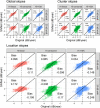Hierarchical Censored Bayesian Analysis of Visual Field Progression
- PMID: 34609479
- PMCID: PMC8496414
- DOI: 10.1167/tvst.10.12.4
Hierarchical Censored Bayesian Analysis of Visual Field Progression
Abstract
Purpose: To develop a Bayesian model (BM) for visual field (VF) progression accounting for the hierarchical, censored and heteroskedastic nature of the data.
Methods: Three versions of a hierarchical BM were developed: a simple linear (Hi-linear); censored at 0 dB (Hi-censored); heteroskedastic censored (Hi-HSK). For the latter, we modeled the test variability according to VF sensitivity using a large test-retest cohort (1396 VFs, 146 eyes with glaucoma). We analyzed a large cohort of 44,371 VF tests from 3352 eyes from five glaucoma clinics. We quantified the bias in the estimated rate-of-progression, the detection of progression (Hit-rate [HR]), the median time-to-progression and the prediction error of future observations (mean absolute error [MAE]). HR and time-to-progression were compared at matched false-positive-rate (FPR), quantified using permutations of a separate test-retest cohort (360 tests, 30 eyes with glaucoma). BMs were compared to simple linear regression and Permutation-Analyses-of Pointwise-Linear-Regression. Differences in time-to-progression were tested using survival analysis.
Results: Censored models showed the smallest bias in the rate-of-progression. The three BMs performed very similarly in terms of HR and time-to-progression and always better than the other methods. The average reduction in time-to-progression was 37% with the BMs (P < 0.001) at 5% FPR. MAE for prediction was very similar among methods.
Conclusions: Bayesian hierarchical models improved the detection of VF progression. Accounting for censoring improves the precision of the estimates, but minimal effect is provided by accounting for heteroskedasticity.
Translational relevance: These results are relevant for quantification of VF progression in practice and for clinical trials.
Conflict of interest statement
Disclosure:
Figures






References
-
- Garway-Heath DF, Poinoosawmy D, Fitzke FW, Hithings RA.. Mapping the visual field to the optic disc in normal tension glaucoma eyes. Ophthalmology. 2000; 107: 1809–1815. - PubMed
-
- Denniss J, McKendrick AM, Turpin A.. An anatomically customizable computational model relating the visual field to the optic nerve head in individual eyes. Invest Ophthalmol Vis Sci. 2012; 53: 6981–6990. - PubMed
-
- Henson DB, Chaudry S, Artes PH, Faragher EB, Ansons A.. Response variability in the visual field: comparison of optic neuritis, glaucoma, ocular hypertension, and normal eyes. Invest Ophthalmol Vis Sci. 2000; 41: 417–421. - PubMed
-
- Chauhan BC, Tompkins JD, LeBlanc RP, McCormick TA.. Characteristics of frequency-of-seeing curves in normal subjects, patients with suspected glaucoma, and patients with glaucoma. Invest Ophthalmol Vis Sci. 1993; 34: 3534–3540. - PubMed
MeSH terms
LinkOut - more resources
Full Text Sources
Miscellaneous

